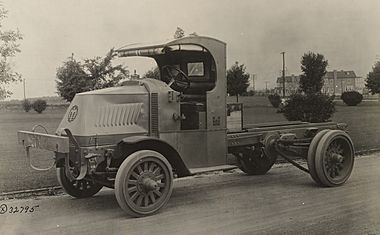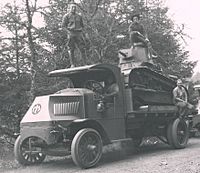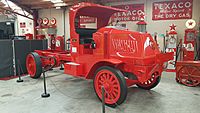Mack AC facts for kids
Quick facts for kids Mack AC |
|
|---|---|

A Mack AC in September 1918
|
|
| Overview | |
| Manufacturer | Mack Trucks |
| Also called | Bulldog |
| Production | 1916–1938 |
| Designer | Edward Hewitt |
| Body and chassis | |
| Class | 31⁄2-ton, 51⁄2-ton or 71⁄2-ton |
| Powertrain | |
| Engine | 4-cylinder 74 bhp (55 kW) petrol |
| Transmission | 3 speed selective with clutch brake |
| Propulsion | 4x2 |
| Chronology | |
| Predecessor | Mack Senior |
| Successor | Mack BC |
The Mack AC was a very strong truck built by the American company Mack Trucks. It was designed in the 1910s and first appeared in 1916.
This truck was used a lot during First World War by the British and American armies. British soldiers gave it the nickname "Bulldog" because it was so tough. This nickname later became the symbol for all Mack trucks.
Contents
How the Mack AC Was Developed
Mack Trucks created the AC model in 1916. It was made to replace an older truck called the Mack Senior, which had been around since 1905.
Edward Hewitt, who was Mack's main engineer, designed the AC. When it first came out, it was very new and special. It had 18 different patents for its unique features. The AC truck was also a good partner to the smaller Mack AB truck, which was also designed by Hewitt.
Mack AC Design Features
The Mack AC was a two-wheel drive truck. This means power went to two of its wheels. It came in three sizes, able to carry heavy loads of about 3.5, 5.5, or 7.5 tons.
The truck had a 4-cylinder petrol engine that produced 74 horsepower. This engine was very strong. A special part of the AC's design was its radiator, which helps cool the engine. It was placed behind the engine, under the hood and near the dashboard. This design helped protect it from damage. The truck's front had a unique square-shaped hood with a small round grille that held the Mack logo. This gave the AC its special look.
The AC's frame, called the chassis, was made from strong steel. It was specially treated to make it very durable. Power went to the back wheels using a chain drive system. The front axle was made of strong alloy steel.
At first, these trucks used solid rubber tires. But later, many AC trucks were made with air-filled tires, which made the ride smoother. The driver's cabin was made of steel, and you could get an optional metal roof. One cool new feature was the steering wheel, which was angled at 45 degrees. This made it much more comfortable for the driver.
Different Versions of the Mack AC
Over the years, Mack made a few different versions of the AC truck:
- The Mack AK was a version of the AC that used a shaft drive system instead of chains. It was made between 1927 and 1936.
- The Mack AP was another version of the AC. It had a more powerful 6-cylinder engine. This model was produced from 1926 to 1938. The AP could be bought with either four or six wheels. The four-wheel version could carry 7.5 tons, while the six-wheel version could carry 10 tons. As an articulated truck (with a trailer), it could carry 15 tons.
- The Mack AL was a special version of the AC. It was designed for delivering goods and for use as fire engines. It had a lower cabin and frame. Only 57 of these unique trucks were made between 1927 and 1929.
How the Mack AC Was Used
The Mack AC truck was used a lot by the armies of the United States and the United Kingdom during First World War. Mack sent about 4,500 AC trucks to the US government, which made it a standard truck for their army. The British military also received about 2,000 AC trucks during the war.
British soldiers really liked the AC because it was so tough and reliable. It could handle very rough conditions and carry extremely heavy loads. British soldiers nicknamed the AC the "Bulldog" because it was so strong and had a short, stubby front. American soldiers also started using this nickname. Because of this nickname, all Mack trucks were often called "Bulldogs." In 1922, the company officially adopted the Bulldog as its symbol.
The Mack AC was a very successful truck for Mack. It stayed in production until 1938. In total, over 40,000 AC trucks were made, along with thousands of AKs and APs.
These trucks were widely used in building projects, like the construction of the Hoover Dam. The AC was one of the strongest trucks ever built. Even in the 1950s and 1960s, you could still see AC trucks from the 1920s driving around American cities. The strong frame of the AC and AP models also made them popular choices for fire engines.
See also
- Mack Trucks in military service



